Characterization of the molecular mechanism underlying gibberellin perception complex formation in rice
- PMID: 20716699
- PMCID: PMC2947161
- DOI: 10.1105/tpc.110.075549
Characterization of the molecular mechanism underlying gibberellin perception complex formation in rice
Abstract
The DELLA protein SLENDER RICE1 (SLR1) is a repressor of gibberellin (GA) signaling in rice (Oryza sativa), and most of the GA-associated responses are induced upon SLR1 degradation. It is assumed that interaction between GIBBERELLIN INSENSITIVE DWARF1 (GID1) and the N-terminal DELLA/TVHYNP motif of SLR1 triggers F-box protein GID2-mediated SLR1 degradation. We identified a semidominant dwarf mutant, Slr1-d4, which contains a mutation in the region encoding the C-terminal GRAS domain of SLR1 (SLR1(G576V)). The GA-dependent degradation of SLR1(G576V) was reduced in Slr1-d4, and compared with SLR1, SLR1(G576V) showed reduced interaction with GID1 and almost none with GID2 when tested in yeast cells. Surface plasmon resonance of GID1-SLR1 and GID1-SLR1(G576V) interactions revealed that the GRAS domain of SLR1 functions to stabilize the GID1-SLR1 interaction by reducing its dissociation rate and that the G576V substitution in SLR1 diminishes this stability. These results suggest that the stable interaction of GID1-SLR1 through the GRAS domain is essential for the recognition of SLR1 by GID2. We propose that when the DELLA/TVHYNP motif of SLR1 binds with GID1, it enables the GRAS domain of SLR1 to interact with GID1 and that the stable GID1-SLR1 complex is efficiently recognized by GID2.
Figures
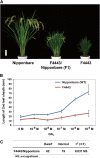
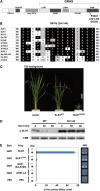
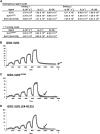
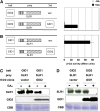

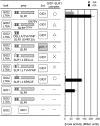



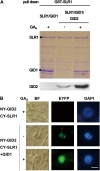

Similar articles
-
Release of the repressive activity of rice DELLA protein SLR1 by gibberellin does not require SLR1 degradation in the gid2 mutant.Plant Cell. 2008 Sep;20(9):2437-46. doi: 10.1105/tpc.108.061648. Epub 2008 Sep 30. Plant Cell. 2008. PMID: 18827181 Free PMC article.
-
A rice gid1 suppressor mutant reveals that gibberellin is not always required for interaction between its receptor, GID1, and DELLA proteins.Plant Cell. 2010 Nov;22(11):3589-602. doi: 10.1105/tpc.110.074542. Epub 2010 Nov 23. Plant Cell. 2010. PMID: 21098733 Free PMC article.
-
The suppressive function of the rice DELLA protein SLR1 is dependent on its transcriptional activation activity.Plant J. 2012 Aug;71(3):443-53. doi: 10.1111/j.1365-313X.2012.05000.x. Epub 2012 May 28. Plant J. 2012. PMID: 22429711
-
Gibberellin receptor and its role in gibberellin signaling in plants.Annu Rev Plant Biol. 2007;58:183-98. doi: 10.1146/annurev.arplant.58.032806.103830. Annu Rev Plant Biol. 2007. PMID: 17472566 Review.
-
GID1-mediated gibberellin signaling in plants.Trends Plant Sci. 2008 Apr;13(4):192-9. doi: 10.1016/j.tplants.2008.02.005. Epub 2008 Mar 11. Trends Plant Sci. 2008. PMID: 18337155 Review.
Cited by
-
Strigolactone and karrikin signal perception: receptors, enzymes, or both?Front Plant Sci. 2012 Dec 28;3:296. doi: 10.3389/fpls.2012.00296. eCollection 2012. Front Plant Sci. 2012. PMID: 23293648 Free PMC article.
-
A Gibberellin-Mediated DELLA-NAC Signaling Cascade Regulates Cellulose Synthesis in Rice.Plant Cell. 2015 Jun;27(6):1681-96. doi: 10.1105/tpc.15.00015. Epub 2015 May 22. Plant Cell. 2015. PMID: 26002868 Free PMC article.
-
Characterization of the procera tomato mutant shows novel functions of the SlDELLA protein in the control of flower morphology, cell division and expansion, and the auxin-signaling pathway during fruit-set and development.Plant Physiol. 2012 Nov;160(3):1581-96. doi: 10.1104/pp.112.204552. Epub 2012 Aug 31. Plant Physiol. 2012. PMID: 22942390 Free PMC article.
-
Cyclophilin OsCYP20-2 with a novel variant integrates defense and cell elongation for chilling response in rice.New Phytol. 2020 Mar;225(6):2453-2467. doi: 10.1111/nph.16324. Epub 2019 Dec 28. New Phytol. 2020. PMID: 31736073 Free PMC article.
-
Role of the gibberellin receptors GID1 during fruit-set in Arabidopsis.Plant J. 2014 Sep;79(6):1020-1032. doi: 10.1111/tpj.12603. Epub 2014 Aug 7. Plant J. 2014. PMID: 24961590 Free PMC article.
References
-
- Abe M., Kobayashi Y., Yamamoto S., Daimon Y., Yamaguchi A., Ikeda Y., Ichinoki H., Notaguchi M., Goto K., Araki T. (2005). FD, a bZIP protein mediating signals from the floral pathway integrator FT at the shoot apex. Science 309: 1052–1056 - PubMed
-
- Aleman L., Kitamura J., Abdel-mageed H., Lee J., Sun Y., Nakajima M., Ueguchi-Tanaka M., Matsuoka M., Allen R.D. (2008). Functional analysis of cotton orthologs of GA signal transduction factors GID1 and SLR1. Plant Mol. Biol. 68: 1–16 - PubMed
-
- Asano K., Hirano K., Ueguchi-Tanaka M., Angeles-Shim R.B., Komura T., Satoh H., Kitano H., Matsuoka M., Ashikari M. (2009). Isolation and characterization of dominant dwarf mutants, Slr1-d, in rice. Mol. Genet. Genomics 281: 223–231 - PubMed
-
- Bassel G.W., Mullen R.T., Bewley J.D. (2008). procera is a putative DELLA mutant in tomato (Solanum lycopersicum): Effects on the seed and vegetative plant. J. Exp. Bot. 59: 585–593 - PubMed
Publication types
MeSH terms
Substances
LinkOut - more resources
Full Text Sources
Other Literature Sources

